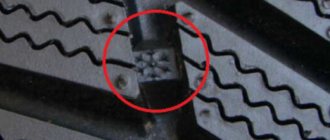How does 2021 legislation regulate tire differentials?
There are 2 legal acts regulating the rules for installing tires on a car:
- Traffic rules and their List of faults (appendix to the Rules) - regulate the conditions when driving a car is prohibited: different tread patterns, different types of tires on different axles of the vehicle and other rules,
- Technical regulations on the safety of wheeled vehicles - this legal act already prescribes regulations for the completeness of vehicles on this issue and concerns more directly the equipment of the vehicle rather than its management.
In our case, the traffic rules will be quite sufficient. This document specifies 2 subtleties of installation:
- different tires on different axles of the car: in front there is a pair of identical tires and in the rear there is a pair identical to each other, but different from those in front,
- unequal tires on the same axle of the car: one on the left, another on the right, front and rear.
But the main subtlety is that the driver is prohibited from operating the car according to traffic regulations. Operation involves driving and controlling the vehicle. Therefore, according to the letter of the law, you can install any combination of tires on your vehicle. It’s just that you are prohibited from driving such a car in certain combinations.
So, let's look at the question of which different tires are not allowed and which ones can be placed on the wheels of a car, and at the end of this article we will provide a summary table.
Tire installation options
There are the following options for installing automobile tires on a car:
- All four wheels are the same.
- There is one identical pair of wheels on the front axle, another pair on the rear axle.
- Three wheels are the same, the fourth is a spare wheel
- The wheels are the same on the sides, but different on the axles
- All wheels are different
In the last two options, movement is prohibited, and when stopped by a traffic police inspector, an administrative protocol will be drawn up, with penalties imposed.
Tires with different tread patterns
Different tires on the front and rear axles
Let's look in order at which unequal tires cannot be installed in pairs on the front and, accordingly, rear axles of the car, and then which ones can be installed.
Studded and non-studded tires – not allowed
The combination of winter and summer tires depends on the conditions, how exactly on the axles it is installed, and whether it is studded or not. So:
- You cannot put summer and winter tires on the same axle on the right and left, respectively,
- Traffic regulations also prohibit the installation of a combination of studded and non-studded tires on the entire vehicle.
Thus, you are also prohibited from driving a car if it has at least one summer tire among the winter studded ones, or one studded tire among the summer ones.
You can install:
- summer tires on the front axle, and winter tires on the rear, but only if the winter tires are studless (Velcro),
- similarly, winter non-studded (Velcro) tires on the front, and summer tires on the rear,
- all-season tires with the same combinations.
The combination of studded and non-studded tires is the only prohibition regarding the possibility of installing rubber on different axles of the car (front and rear). The traffic rules do not provide for any other restrictions. In particular, you can put:
- tires from one manufacturer on the front axle, tires from another on the rear axle,
- similarly, dimensions may vary: height, radius and profile,
- tread pattern,
- tube tires and tubeless tires,
- diagonal and radial design.
Is it possible to put different tires on different axles from the point of view of traffic regulations?
There is a special application in the traffic rules regulating the use of wheels. It sets out the following requirements for car tires:
- The minimum tread depth must be at least 1.6 mm for summer tires. Winter and all-season tires must have a minimum of 4 mm of tread. All of the above figures apply to passenger car tires.
- It is allowed to operate tires without external damage: holes, delaminations and protruding cords.
- Tires must match the vehicle's load capacity and size.
There are also a number of requirements for wheel rims. The most important thing is the absence of visible damage, such as chips and cracks. The discs must be equipped with all necessary bolts and nuts.
Clause 5.5 of the Road Traffic Regulations clearly prohibits the use of different tires on the same axle of a vehicle.
By “different” we mean the following options for using tires:
- Tires with different tread patterns.
- Structurally different tires: tubed and tubeless.
- Tires for different seasons - winter and summer.
- New and refurbished.
- Studded and without studs.
ATTENTION! All of these options are strictly prohibited. There is a fine for violators of these requirements. It is only allowed to use identical tires that differ in the degree of wear.
Thus, we received an answer to the question: “Is it possible to install different tires on different axles?” According to traffic regulations, this option is permitted for passenger cars. Only the combination of studded and non-studded tires is prohibited. That is, all wheels of the car must have either studless or studded tires.
There are good reasons to prohibit the use of different tires on the same axle. This is dictated by safety requirements. That is, during braking, different tires will behave unpredictably. The effect is enhanced on wet or slippery asphalt.
The amount of the fine for driving a car with different tires on the same axle is determined by the article of the Code of the Russian Federation on Administrative Offenses and is 500 rubles.
We recommend
“What do the letters on car tires mean: decoding of all indices” Read more
Important note!
- This article provides basic information, but each case is different.
- In 92% of all situations there are important nuances that can affect the outcome of the entire case.
- An experienced lawyer will study all the materials of the case and indicate in which direction to move.
Therefore, our website employs on-duty legal consultants who delve into each case and are aimed at solving it.
Ask a Question
or consult toll-free (Moscow), (St. Petersburg), 8 (all of Russia).
Different tires on the same axle: left and right
But here there are much more restrictions. Let's look at them all according to the criteria for tire differences.
Studded and non-studded
- not possible: on one axis and in pairs on different axes,
- you can: only either all studded or all non-studded.
Forbidden! If you have non-studded tires on the left and studded tires on the right, then you will face a fine from the traffic police officer (about its size and nuances below). This applies to both the front and rear axles.
Moreover, as we have already emphasized above, you cannot install
Different winter or summer
- not possible: on one axis,
- possible: in pairs on different axes.
This means if it is summer tires and Velcro instead of studded. In this case, the 2021 traffic regulations also prohibit the installation of such a tire combination.
Tires of different manufacturers or models
- not possible: on one axis,
- possible: in pairs on different axes.
The rules stipulate that either the front or rear tire models must not be different. It follows that manufacturers should not differ either. If, for example, Nokian Hakkapeliitta 3 tires are used on the left, then on the right you cannot install not only any Michelin X-Ice, but even another model from the same manufacturer - for example, Nokian Hakkapeliitta 2 or 4.
Different sizes: radius, width and profile
- not possible: on one axis,
- possible: in pairs on different axes.
The legislation does not directly describe exactly what technical parameters should be the same for rubber symmetrically located on the same axis. But he emphasizes that it is prohibited to install tires of different sizes. But the dimensions, logically, include the profile, the width, and the same radius. Therefore, such tires cannot be used on one axle. But on different axes in pairs - it’s possible.
With different tread patterns
- not possible: on one axis,
- possible: in pairs on different axes.
Obviously, a different pattern means that you have tires of different models and perhaps even manufacturers. This is prohibited under the 2021 traffic rules.
But even if somehow it turns out that the models coincide, the Rules still directly prohibit the installation of tires with different tread patterns on the wheels of a car.
With different tread wear
- possible: on one axis, but with two subtleties,
- possible: in pairs on different axes.
So, the Road Traffic Rules do not directly prohibit the use of tires with different wear. But there are 2 things that are specified in the conditions under which it is prohibited to drive on different tires:
- if there is a new tire on the left and a retreaded one on the right, and vice versa,
- if on the left there is a new tire, and on the right - with an in-depth pattern, and vice versa.
Please note that this only applies to installing tires on one axle. You can bet such combinations on different pairs.
Tube and tubeless
- not possible: on one axis,
- possible: in pairs on different axes.
Something that may surprise many drivers. In fact, you are prohibited from placing a tire with a tube on one side and a tubeless tire on the other. Unexpectedly, but this is the letter of the law!
When winter meets summer
The rules do not prohibit the installation of winter non-studded wheels on one axle and summer wheels on another throughout the year, except for the three winter months. Sometimes they do this if they need to slightly increase the vehicle’s cross-country ability (winter tires, as a rule, have more pronounced lugs), but there is neither the money nor the desire to spend money on special off-road tires. They put more passable tires on the drive axle, clearly understanding that the car will be prone to breaking this axle, which is especially dangerous on rear-wheel drive, but can cost gray hairs on front-wheel drive as well.
If the wheels are different - when is it possible and when is it not?
What about the spare tire?
And with it everything is quite simple - it is not installed on the car, and the Basic Provisions of the Traffic Regulations regulate restrictions only on the installed wheels. Therefore, the spare tire may differ from the tires on the car in absolutely all of the above parameters.
But from here an important “but” becomes obvious - this concerns the inspection by the traffic police inspector of it, which is in the trunk. If you puncture a tire and put a spare tire in its place, then an offense will be created if the tires become different in one of the prohibited combinations listed above.
What else is not allowed for tires and wheels?
Traffic regulations stipulate not only different tires in the form of their established combinations, but also other requirements for each of them. Among them:
- residual tread depth when summer tires wear out – at least 1.6 mm (for passenger cars),
- residual tread depth when wearing winter tires (studded or non-studded - it doesn’t matter) - at least 4 mm (for passenger cars),
- if there are cuts or tears on the tire, provided that the cord is visible from them (nylon on the side or metal on the tread - it doesn’t matter),
- if the tire tread has peeled off from the sidewall,
- if the tires have a load rating that is different from what is allowed for your car,
- if the tire sizes are not provided for by the design of the car (the inspector can check this and compare it on the plate on the side of the door or inside the gas tank cap with the recommended tire pressure),
- if the disks are missing at least one bolt/nut, and also if the mounting holes are worn out or damaged, or if the disks themselves are damaged (chips, cracks).
They don't sell the tires you need
The required model in the required standard size is not always available. In this case, try to purchase tires with the most similar tread pattern. However, do not forget that tires from different manufacturers have different grip on the road. And who knows, maybe a slightly worn old pair will still cling better than a freshly purchased pair. Therefore, if you put new tires on the rear axle, the grip at the rear will be worse than at the front. What this threatens was presented earlier.
Moreover, it is almost impossible to determine the moment when, due to wear, the grip on the rear axle becomes better than on the front axle. And it will also not be possible to level the remaining tread depth through rotation.
What is the fine for different tires?
For any violations of the List of Faults as an appendix to the Traffic Regulations, the Code of Administrative Offenses valid for 2021 provides for a fine of 500 rubles or a warning. This is provided for in Part 1 of Article 12.5 of the Code. It prescribes a single fine specifically for violations of the Basic Provisions of Traffic Regulations - any conditions and malfunctions under which it is prohibited to drive a car.
In rare cases, the traffic police inspector may also issue a requirement to eliminate the conditions leading to the offense and show the car to the traffic police within 10 days with the fault corrected (with the same tires, if different, this is a violation of the Rules). Otherwise, according to the employee’s report, the car’s registration is canceled, and then the license plates will be put on the wanted list, and the very first stop by another traffic police officer will then lead to a impound lot and the confiscation of license plates and registration certificates.
But let us repeat, this happens very rarely, and most often the requirements are issued for tinting, excessive tuning (sports muffler, etc.), or if you installed completely different wheels - for example, you made a “bigfoot” out of a car.
Finally, we note that the restriction on the use of different tires is expressed in a specific paragraph of the traffic rules - 5.5 of the List of faults.
Is it safe to use different tires?
At the very first stop by a traffic police officer, you can get a fine for different tires - which one, you already know. You need to be afraid not of payment or warning, but of the serious consequences of your negligence. Let's look into the situation. Let's say on a car one tire works great on dry roads, and the other is designed to prevent loss of traction in the rain (hydroplaning). If there is a film of water on the track, one wheel will cope with the situation, and the other will skid. First of all, for the driver it is stress, which is already enough on the road. Let's look at options for using different tires.
We recommend
“Fine for summer tires - is there one and what is it?” More details
Summer and winter tires
If you didn’t have time to change your tires for the season or simply decided not to do it, a traffic police officer may hold you financially liable. How much is the fine for different tires (summer and winter)? The amount for installing different tires is 500 rubles. All wheels must “change shoes” when replacing summer tires with winter tires and vice versa. Sometimes something happens to one of the tires. In this situation, you can try to find a replacement for it. If this fails, you need to buy two identical tires and install them on one axle.
There is no penalty for different tires on the front and rear axles, unless it concerns the simultaneous use of winter tires with studs and summer tires without them. In other words, all tires must be studded or studless, and tires must be installed according to the season.
Experts are of the same opinion: it is undesirable to combine tires for winter and summer. Such a combination, due to the different grip of the two types of tires on the road, can lead to skidding.
The fine for tires selected out of season can reach 2,000 rubles. Therefore, vehicle owners take great responsibility in finding the ideal tire option for their car.
Tires for winter and summer are even visually different. Cold weather tread is deeper and rougher. Winter tires also have a completely different pattern compared to summer tires. Another feature of winter tires that allows you to maintain vehicle controllability on slippery roads and ice is the presence of studs.
Summer tires are made of rubber that can withstand high temperatures. They should not be damaged when used on hot asphalt. Rubber for summer is elastic, however, this property is lost with strong temperature changes.
The composition of winter tires is selected in such a way that the car has good adhesion to the road surface. Spikes allow you to maintain excellent handling in icy and snowy weather. When the ambient air temperature rises (more than +1 °C), driving on winter tires becomes very dangerous. Another feature of winter tires is increased rigidity compared to the summer version.
You can also find all-season tires in the store's assortment. When choosing this tire option, take into account the type of driving you plan to use and the roads you plan to drive on. For example, good grip is necessary for comfort on hard road surfaces. Here, tires with spikes will come in handy.
Different tread on the front and rear axle
There is no penalty for different tires on the front and rear. Vehicle owners fearlessly install different tires on the front and rear axles. Due to the lack of difference in the wheels, the car should handle well on the road. Previously, it was considered normal to combine tires for summer and winter. In most cases, summer tires are installed on the front axle and winter tires on the rear axle.
At the legislative level, there are no sanctions for installing tires with one pattern on the front axle and another on the rear axle. There is also no prohibition on operating a car that has two identical tires on the front axle and two identical ones on the rear, but the tires on the front and rear are different from each other. The main rule is to install identical tires on one axle so that the car handles well. In this case, even during emergency braking, the car will not skid. Thus, different tires on the front and rear axles do not pose a danger on the road.
Different treads on one axle
According to the Road Traffic Rules, the tires on one axle should not be different. You cannot use tires that have a different pattern for each wheel. We are talking about prohibiting the installation of reconditioned and new tires on the same axle. Do you know what a retreaded tire is? This is a type of rubber that is returned to the factory after complete wear. In production, a restoration procedure is carried out by covering a worn tire with a new tread layer.
If one tire has a tube and the other does not, they are different models. It is prohibited to install such tires on one axle. Please note that tires on different axles may vary significantly.











